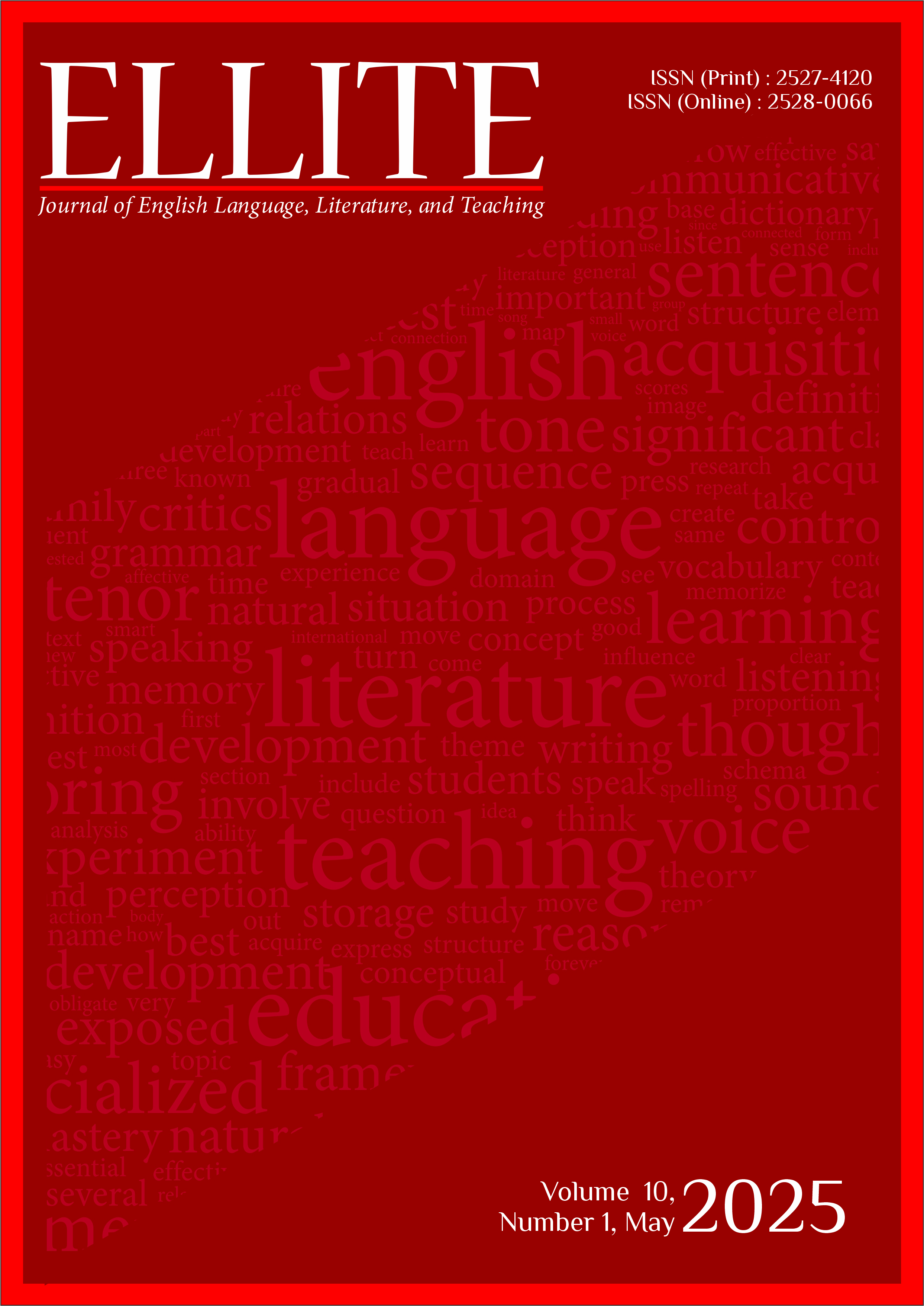Clear or Confusing? Investigating Pronunciation Challenges Among Young EFL Learners in Southern Thailand
DOI:
https://doi.org/10.32528/ellite.v10i1.3061Keywords:
Pronunciation; Barriers; EFL; ThailandAbstract
This study seeks to explore the pronunciation difficulties encountered by students at Tessaban 2 Ban Sadao School in Thailand. Utilizing qualitative research methodologies, which include pronunciation evaluations and semi-structured interviews with educators, the research aims to identify prevalent pronunciation mistakes and analyze the instructional strategies employed by teachers. The results indicate that students face challenges with particular phonemes, such as /r/, /v/, /ʃ/, and final consonant clusters, primarily influenced by their first language (L1). Furthermore, issues related to incorrect word stress and unsuitable intonation patterns impede clarity and understanding in spoken communication. Educators implement a variety of techniques, such as phonetic training, minimal pair exercises, and imitation practices, to help students enhance their pronunciation skills. Nevertheless, the limited exposure to authentic English language contexts continues to pose a significant obstacle. This research highlights the critical need for a stronger focus on pronunciation within the English language curriculum, as well as the importance of providing students with increased opportunities to interact with genuine English-speaking environments. By tackling these challenges, educators can formulate more effective and targeted teaching strategies, ultimately improving the pronunciation and communication abilities of EFL (English as a Foreign Language) learners in Thailand.
References
Aqeel, M., Waqar, S., Majeed, S. A., & Kiran, S. (2023). Role of English Language as a Global and Economical Language Around the Globe: A Case of Kachru's Model. Bulletin of Business and Economics (BBE), 12(4), 141-147. https://doi.org/10.61506/01.00096
Baker, W., & Jarunthawatchai, W. (2017). English language policy in Thailand. European journal of language policy, 9(1), 27-44. (doi:10.3828/ejlp.2017.3).
Baker, W., Bowles, M., Foote, R., Perpinán, S., & Bhatt, R. (2008). Social, experiential, and psychological factors affecting L2 dialect acquisition. In Selected Proceedings of the 2007 Second Language Research Forum (pp. 187-198). Somerville, MA: Cascadilla Proceedings Project.
Brown, H. D. (2007). Principles of language learning and teaching. White Plains, NY: Pearson Education.
Chakma, S. (2014). Difficulty in pronunciation of certain English consonant sounds. Sripatum Chonburi Journal, 10(3), 110-118.
Edwards, J. G. H. (2017). Pronunciation and individual differences. In The Routledge Handbook of Contemporary English Pronunciation (pp. 385-398). Routledge.
Elanthiraiyan, R., & Priyanath, H. M. S. (2023). The impact of socioeconomic status on the self-efficacy and English language proficiency of English language teachers in the rural area: A case of Passara Education Zone in Sri Lanka. Sri Lanka Journal of Social Sciences and Humanities, 3(2).
Felker, E., Janse, E., Ernestus, M., & Broersma, M. (2023). How explicit instruction improves phonological awareness and perception of L2 sound contrasts in younger and older adults. Linguistic Approaches to Bilingualism, 13(3), 372-408.
Georgountzou, A., & Tsantila, N. (2017). Cultural identity, accentedness and attitudes of Greek EFL learners towards English pronunciation. Selected papers on theoretical and applied linguistics, 22, 160-174.
Gilakjani, A. P. (2012). A study of factors affecting EFL learners' English pronunciation learning and the strategies for instruction. International Journal of Humanities and Social Science, 2(3), 119-128.
Hansen Edwards, J., Chan, K. L. R., Lam, T., & Wang, Q. (2021). Social factors and the teaching of pronunciation: What the research tells us. RELC Journal, 52(1), 35-47.
Hayes, D. (2016). The value of learning English in Thailand and its impact on Thai: Perspectives from university students. Asia Pacific Journal of Education, 36(1), 73-91.
Jones, T. (2017). Pronunciation with other areas of language. The Routledge handbook of contemporary English pronunciation, 370-384.
KanokPermpoon, M. (2007). Thai and English consonantal sounds: A problem or a potential for EFL learning? ABAC Journal, 27(1).
Karmida, K., Hasibuan, A. L., & Nurlaili, N. (2024). An Analysis of Students’ Low Confidence in Speaking, As the Attribute of Pronunciation Context. Journey: Journal of English Language and Pedagogy, 7(2), 331-336.
Kostromitina, M., & Kang, O. (2021). The effects of ESL immersion and proficiency on learners’ pronunciation development. Frontiers in Communication, 6, 636122
Kuo, L. M. (2021, September). An action research on the effective English phonetic learning for college students. In 2021 International Conference on Modern Management and Education Research (MMER 2021) (pp. 119-122). Atlantis Press.
Le, H. T., & Boonmoh, A. (2020). Thai students' production of English coda clusters: An experiment on sonority with Thai university students taking an English fundamental course. Human Behavior, Development & Society, 21(2).
Liu, M., & Huang, W. (2011). An exploration of foreign language anxiety and English learning motivation. Education Research International, 2011(1), 493167.
Moyer, A. (2013). Foreign accent: The phenomenon of non-native speech. Cambridge University Press
Munro, M. J., & Derwing, T. M. (2011). The foundations of accent and intelligibility in pronunciation research. Language Teaching, 44(3), 316-327.
Munro, M., & Mann, V. (2005). Age of immersion as a predictor of foreign accent. Applied Psycholinguistics, 26(3), 311-341.
Ozfidan, B., & Burlbaw, L. M. (2019). A Literature-Based Approach on Age Factors in Second Language Acquisition: Children, Adolescents, and Adults. International Education Studies, 12(10), 27-36.
Paudel, P. (2024). Embracing opportunities and navigating challenges: Teaching pronunciation in the EFL context of Nepal. KMC Journal, 6(2), 85-105.
Pennington, M. C., & Rogerson-Revell, P. M. (2018). English pronunciation teaching and research: Contemporary perspectives. Palgrave Macmillan.
Phusit, N., & Suksiripakonchai, W. (2018). A study of Thai university students’ attitudes towards pronunciation models in English as a lingua franca. International Journal of Social Science and Humanity, 8(1), 20-24.
Pourhossein Gilakjani, A. (2016). English pronunciation instruction: A literature review. International Journal of Research in English Education, 1(1), 1-6.
Rasheed, M. (2024). Impact of First Language (L1) on Second Language (L2) Pronunciation: A Case Study of Undergraduate ESL Learners in Pakistan. Journal of English Language, Literature and Education, 6(1), 81-113.
Shukurdinovna, S. O. (2024). Choosing authentic materials in english teaching: a comprehensive framework for effective language acquisition. International Journal of Pedagogics, 4(03), 105-111.
Sridhanyarat, K. (2017). The acquisition of L2 fricatives in Thai learners’ interlanguage. 3L: Southeast Asian Journal of English Language Studies, 23(1).
Tantiwich, K., & Sinwongsuwat, K. (2021). Thai university students' problems of language use in English conversation. LEARN Journal: Language Education and Acquisition Research Network, 14(2), 598-626.
Wei, Y., & Zhou, Y. (2002, April 2-10). Insights into English pronunciation problems of Thai students. (Presented at the Annual Meeting of the Quadruple Helix, Eighth Annual Spring Conference: Quadruple Helix, jointly, Thailand).
Downloads
Published
Issue
Section
Categories
License
Copyright (c) 2025 Dara Urona, Faizatul Husna, Rena Juliana, Subaidah Lemsoh

This work is licensed under a Creative Commons Attribution 4.0 International License.






